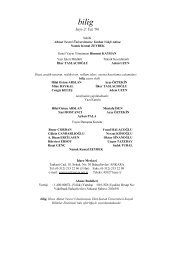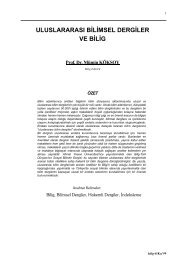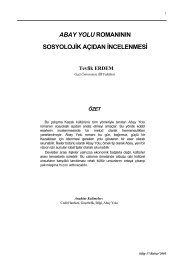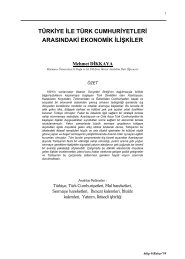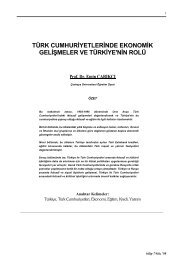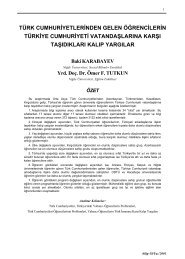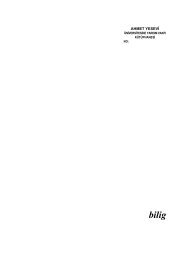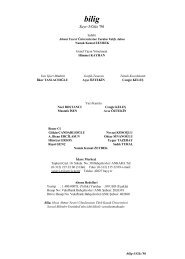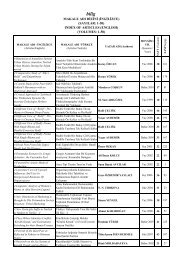Asya Tipi Üretim Tarzı'na Veda - Bilig
Asya Tipi Üretim Tarzı'na Veda - Bilig
Asya Tipi Üretim Tarzı'na Veda - Bilig
You also want an ePaper? Increase the reach of your titles
YUMPU automatically turns print PDFs into web optimized ePapers that Google loves.
Main Heading: These can be used for the summary, sections of the main text, acknowledgement<br />
(if any), references and appendice (if any). THESE HEADINGS SHOULD BE CAPITALISED.<br />
Interval Headings: should be in bold and should be in a smaller font size than main heading;<br />
only the first letters of each word should be in capital, At the end of each Interval Heading a new<br />
paragraph should be started.<br />
Sub-headings: should be in bold; only the first letter of the first word should be in capital and the<br />
writing should continue on the same line after a colon(:).<br />
FIGURES AND TABLES<br />
Figures should be drawn on transparent or vvhite paper in ink so as not to cause problems in<br />
printing or reducing in size. Each figure should be on a separate page and should be numbered with a<br />
caption of the title below it.<br />
Tables should also be numbered. They should have titles below. The titİes of the figures and<br />
tables should be clear and concise. The first letters of each word should be capitalised. When<br />
necessary footnotes and acronyms should be below the captions.<br />
PICTURES<br />
Should be on highly contrasted photo papers. Rules for figures and tables are applied for pictures<br />
as well. In special cases colored-pictures may be printed.<br />
The number of pages for figures, tables and pictures should not exceed ten pages. Authors<br />
having the necessary technical facilities may themselves insert the related figures, drawings and<br />
pictures into the text. Those without any technical facilities will leave the pro-portional sizes of<br />
empty space for pictures within the text numbering them.<br />
Stating the Source Within the Text:<br />
The following examples should be observed when giving the source within the text. Sources will<br />
not be given as footnotes.<br />
a. Quoting a single or multi-authored source; first the last name of the author is written and then<br />
the date is written in parenthesis as shown in the example.<br />
…………….Köksoy (1998)<br />
…………….Some authors (Bilgegil 1970; Kaplan 1974; Aktaş 1990)<br />
b. When multi-authored sources are mentioned, the name of first author is written forothers (et.<br />
al) is added.<br />
…………….İpekten, et. al., (1975).<br />
Full reference including ali the names should be given in the list of references at the end of the<br />
article.<br />
c. If an unreachable source is quoted within the text from an available source it should be<br />
indicated as follows:<br />
…………….Köprülü (1911: in Çelik 1998)<br />
d. Personal Communications can be indicated by giving the last name(s), the date(s) but full<br />
references should be stated at the end of the article.<br />
LIST OF REFERENCES<br />
a. For periodicals:<br />
The name(s) of authors), date, the title of the article, the name of the periodical in full, volume,<br />
issue and page numbers should be quoted.<br />
b. For papers submitted at conferences and lor symposiums:<br />
The name(s) of author(s), the date, the title of the paper(s), the name/title of the<br />
conference/symposium, editor(s), publishing company, volume number, place of organization and<br />
page number should be indicated<br />
211




